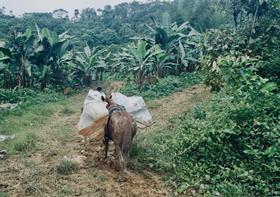
In an era of climate change, biodiversity loss and pollution, farming practices are under the microscope like never before. Technology and smart-farming methods relying on big data and robotic advances are seen as the solution, but older techniques are also effective in combating environmental degradation. Ecuadorian banana exporter Banabio sources bananas from smallholder farmers who practice an agricultural method called “agroforestry”.
Promoted by the UN’s Food & Agriculture Organization, agroforestry methods draw on the time-honoured principle of strength through diversity. The aim of agroforestry is in restoring a diversity of plant life onto the farm by mixing perennial trees and even livestock with food crops.
Banabio’s Patricia Rodriguez says: “It’s not a very common way of farming, they are usually families who have done it for decades. It’s unusual because it’s not very profitable. It’s more out of conviction and heritage.” Rodriguez says that most agroforestry banana producers are found in the higher altitudes of Ecuador, where fog is ever present and access is difficult.
According to Banabio’s Victor Hugo Marín and Patricia Zamora from Abansur, an association of small and medium-sized growers for Banabio, one of the key benefits from agroforestry is in soil health. With a greater biodiversity on the farm, the ecosystem has a more abundant set of resources. Leaves from the trees that fall to the ground provide nutrients, as do roving animals. A greater abundance of plants also means more roots in the soil that increases the availability of nutrients in the ground.
“If you have a monocrop there’s little vegetation, you don’t have a huge biodiversity to help the soil, and the capacity of the soil is less, the nitrogen levels are lower, and the water also runs over the surface. It also works as a tool against climate change. Plants remove CO2 from the atmosphere through photosynthesis and fix it into their biomass,” Rodriguez adds.
Agronomists like Marín and Zamora provide smallholder agroforestry banana producers with the technical expertise to help get the most out of their farm, including training programmes on organic farming, and pest control. But crops grown using the agroforestry method actually yield more fruit per tree due to the extra-fertile soils.
Despite this, the technique provides much less overall due to the mixed nature of the farm. “Forest farming is considerably less profitable than traditional agriculture. Quantitatively this means that the yield of an agroforestry farm is 500 boxes of bananas/hectare per year, while a traditional one produces 2,500 boxes/ha per year,” Rodriguez says.
In the face of growing environmental damage, however, there is a desire for developing the agroforestry method from groups like FAO, but Rodriguez says there would need to be top-down support for the smallholders to make it work.
“In public administration, aid is more focused on promoting marketing measures for the agroforestry products, but at local level consumption. In the particular case of Banabio, we support associations of small-sized farmers that support these practically non-existent crop methods. All of which is to suggest that the government’s aid is necessary to move agroforestry forward.
“But it is also necessary to have a paradigm shift in the global pattern of consumption. As consumers we should be more aware of all the impacts a product may have, and advocate for the more responsible option, as it happened with the transition from conventional to organic agriculture. The latter is nowadays more popular than a decade ago, so the same could happen with agroforestry.”



